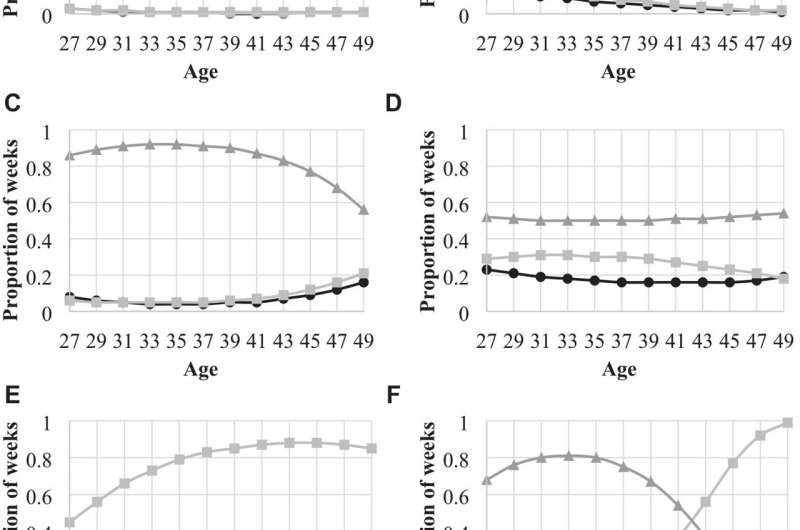This article has been reviewed according to Science X's editorial process and policies. Editors have highlighted the following attributes while ensuring the content's credibility:
fact-checked
trusted source
proofread
Debunking the myth of steady male employment

Steady employment has long been the assumed standard associated with the American man, especially by the Baby Boomer generation. New research is pushing back on the archetype and shedding light on the potential consequences of upholding the "breadwinner" ideology in a labor market in which reality is strikingly different.
In work recently published in Socius, researchers at Penn State and Ohio University Heritage College of Osteopathic Medicine found that only 41% of Baby Boomer men who were studied followed a trajectory of continuous, high employment over the duration of their prime earning years.
Instead, most men in the study followed less stable employment paths that included increasing unemployment, time out of work but not seeking employment due to personal reasons or periods of intermittent work.
"It's way more movement than we would expect," said Sarah Damaske, professor of sociology and labor & employment relations, associate director, Population Research Institute at Penn State and one of the study's authors. "There's this stereotype that men don't move in and out of the workforce, that they go to work, they stay in, and they're done when they're 65. The big picture is that men's work is not nearly as stable as we think, particularly for men who have a high school degree or less."
In a previous study, Damaske worked with a team of researchers that found that unemployment—particularly chronic unemployment—can have serious health implications—in part due to a lack of health care while unemployed. Even those who experience a higher risk of unemployment into their early 30s can be at risk for poorer health at midlife.
"Some of our earlier work has really shown that some of these things matter a lot for your health at midlife," Damaske said. "Previous studies have found that failing to achieve these perceived employment norms can negatively affect men's health, create financial instability, reduce their social status and strain their personal relationships, among other things."
The authors investigated the diversity of men's workforce experiences using the 1979 cohort of the National Longitudinal Survey of Youth, which consists of a group of 4,538 men who were born between 1957 and 1964 and living in the U.S. in 1979.
The researchers measured men's workforce participation every two years between ages 27 and 49—almost the entirety of their prime working-age years—during calendar years 1984 to 2021. They identified six categories of men's time spent employed, unemployed and out of the labor force.
While 41% followed a steady workforce participation trajectory, 25% had bouts of unemployment and time out of the labor force early in their careers, followed by increasingly steady work. The opposite occurred for 13% of the men, who started out stably employed, followed by increasingly unsteady work. The remaining 21% of men in the study experienced much more precarious employment, including periods of intermittent workforce participation and early exits from work.
"These data allowed us to see longitudinal patterns of men being in and out of the workforce, as opposed to the snapshot of the labor market that you'd see from the census data that just tells you who's in and who's out at a given period of time," said Adrianne Frech, associate professor of population health at Ohio University Heritage College of Osteopathic Medicine–Cleveland.
She noted that the rise of precarious work, such as increases in involuntary part-time work and in risk of job loss; the decline of good jobs for men, including declines in unionization and in health benefits at work, and recent recessions may have contributed to men's declining workforce participation.
With fewer men steadily employed than previously thought, the researchers said the findings could raise implications for how policymakers conceptualize and act on men's work experiences.
"For employers, specifically, the data may suggest that if they don't want to have intermittent workers, that the work needs to be rewarded at a rate where people are less likely to feel they have to leave," Damaske said.
In future studies, the researchers plan to look at labor market precarity, specifically at the labor market policies that may lead to higher rates of unemployment.
More information: Adrianne Frech et al, The Myth of Men's Stable, Continuous Labor Force Attachment: Multitrajectories of U.S. Baby Boomer Men's Employment, Socius: Sociological Research for a Dynamic World (2023). DOI: 10.1177/23780231231197031
Provided by Pennsylvania State University




















